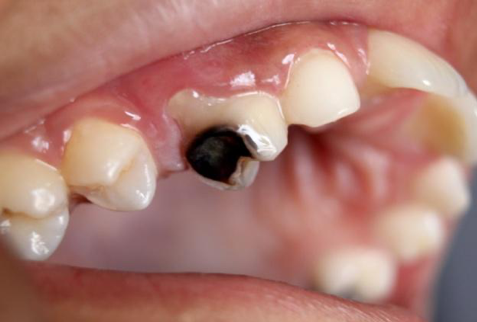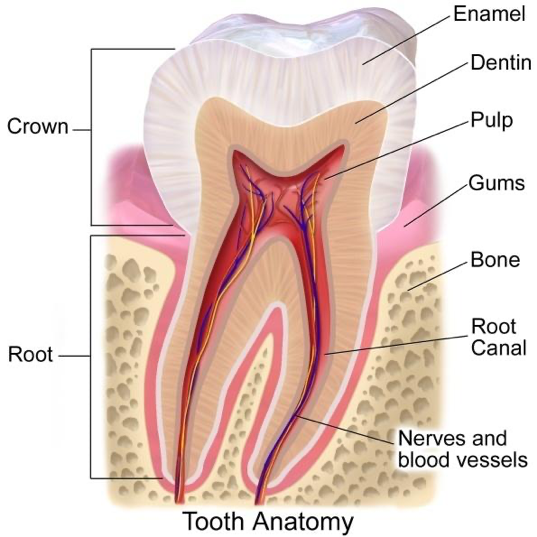Are you experiencing unbearable tooth pain and think it’s a cavity or even a root canal? Do you remember when it started? Are you aware of the reasons behind the growing pain in your tooth? Well, it’ll surprise you to know that over 25 percent of the adult US population ignores their dental problems.
However, pain in a tooth can occur for several reasons. Perhaps, tooth extraction or a mouth injury may be the reason you’re experiencing pain. But what about cavities and root canal infections? Read on to determine if the pain in your tooth is due to a cavity or a root canal infection.
What is a Cavity?
It’s not easy to detect a cavity until it gets worse. After all, your teeth are made up of the hardest and most rigid tissue in the entire human body, i.e., the enamel. The second layer is that of the dentin muscle. And finally, the third layer is soft tissue pulp at the core of your tooth, which runs roots into the jaw.

(Source)
However, when there are small holes and openings in your tooth’s hard surface, it is a clear sign of cavities. These are damaged areas, often permanently, called tooth/ dental decays (caries). Thus, cavities on your tooth show a clear picture of bacteria and germ accumulation.
What Treats a Cavity?
What treats a cavity? Well, let’s talk about the prime cavity treatment, that is, a dental filling (often, tooth filling). You might have heard someone call dental filling a “plug up” therapy. Well, it’s not a lie. Dental filling involves the complete removal of the decay on your tooth. This leaves behind an empty space.
Hence, filling the space with minerals/ materials leads to the return of painless functionality to your tooth. Modern fillings include human-body-friendly substances that recreate the natural look of your teeth to ensure protection from recurring cavities and decay.
When Do You Need a Dental Filling?
Endodontists or general dentists usually treat cavities by performing dental fillings. Nonetheless, how do you determine if you need a dental filling?
- Holes in your tooth
- Dark spots on your tooth
- Floss tussles in between a tooth
- Pain when you touch your tooth
- Sharp pains in the jaw, tooth, or gums
- Rough sensation after touching your tooth with your tongue
While you may not feel any of the symptoms above, you should keep in mind, cavities at the initial stages do not cause any sort of discomfort or pain. What’s more, the tiny holes might only be visible to an expert endodontist.
What’s a Root Canal?
A root canal involves the removal of infected soft pulp in your tooth’s core. The common cause of infection in a root canal is dental decay and tooth chipping/ cracking/ breaking. Did you know that the infection or inflammation that occurs in the tooth pulp can spread to other parts of your mouth?

(Source)
A root canal therapy ensures the complete removal of the infected pulp, cleaning of the tooth canal(s), and filling (of the empty space) to ensure protection from bacteria. Your endodontist might suggest crown placements to cover the affected tooth after treatment. This way, the tooth features a natural look, and the root canal seal remains protected as well.
Causes of Infection Leading to Cavities
Although cavities occur on the hard surface or sometimes on the second layer (dentin) of your tooth, they can progress to the root of your tooth. Consequently, they cause an infection in the soft pulp of your tooth’s core. Here are some causes, besides dental decay, that can lead to root canal infections.
- Avulsed tooth
- Chipped or cracked tooth
- Sterile necrosis (i.e., tooth concussions)
- Abnormality in tooth anatomy
- Tooth displacement
- Excessive dental treatments
When Do You Need a Root Canal?
How do you determine whether your oral condition requires root canal therapy? Or perhaps, multiple root canal therapies? Here are some of the symptoms of root canal infection that point towards root canal therapy:
- Tooth sensitivity: consuming something cold or hot leads to pinching and pain sensations in the tooth. Mainly, tooth sensitivity arises when infectious germs or bacteria damage the nerves that connect to the sensitive tissues in the jaw.
- Swollen gums: the decayed pulp (infected or dead) inside the tooth produces acidic waste. Hence, affecting the gums, causing them to swell, tenderize, or be painful to slight touch.
- Consistent pain: recurring and long-lasting tooth or gum pain is a major symptom of root canal infections.
- Loose tooth: your tooth might seem mobile/ loose because the dead pulp elevates it (swelling on the gums also contributes)
- Discoloration of tooth: color change of tooth occurs due to hindered blood supply or damage to the structuring tissues, leading to a blackish appearance.
Cavity or Root Canal: Conclusion
Although you will find extensive research, studies, and data online, the best way to treat pain in the tooth is to consult the best endodontist or general dentist in your area. In Manhattan, Dr. Young Bui DDS offers extensive dental care with the use of modern technology,
Having performed over 15,000 root canals and other dental treatments, Dr. Young Bui at Bryant Park Endodontics provides compassionate dental care to his patients. Give Bryant Park Endodontics a call at 646-205-3045 to schedule an appointment.
Remember: the best way to preserve your health is to be proactive, not reactive.
